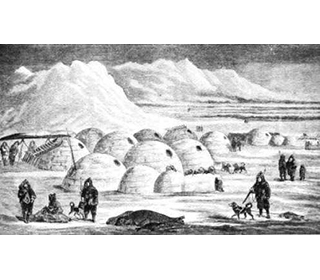Facts about the Inuit Native Indian Tribe: Lifestyle and Culture
The lifestyle of the Inuit tribe was hard, dictated by the cold, harsh climate and the barren, desolate landscape of the Artic tundra which has been aptly described as a 'snow desert'. The name “Inuit” means “the people” in the Inuktitut dialect of their language. At one time they were referred to as "Eskimo". The word "Eskimo" derives from an Algonquian word meaning "Eaters of Raw Flesh". The word Eskimo was used to described the Inuit, Yupik and Inupiat people. The name Eskimo is used less frequently than in the passed in deference to the wishes of the Inuit people. Communities of Inuit people are found across the Arctic and are most closely related to the Aleut people. The chief source of food are whales, sea lions, seals and walruses. Smaller fish, and land animals such as caribou and small birds were also part of their diet. The Inuit lived either in tents made of Caribou hides, or in igloos as seen in the above picture. Where did the Inuit tribe live?
The Inuit are people of the Arctic Native American cultural group. The location of their tribal homelands are shown on the map in present-day Alaska, Canada and Greenland. The geography of the region in which they lived dictated the lifestyle and culture of the Inuit tribe. - Land: An inhospitable landscape consisting of a flat, stark, cold and snowy, treeless, tundra region
- Climate: Extreme, cold arctic climate
- Animals: The animals included seal, caribou, sea lions, otter, polar bears, arctic hare, whale, walrus and Artic birds
- Natural Resources: Fish, limited seasonal berries and plants
- Transport: Dogsleds (qamutik), snowshoes, and leather-covered, watertight canoes and open fishing boats such as Inuit Kayaks
What did the Inuit tribe live in?
The Inuit tribe tribe were semi-nomadic and needed shelters that were easy to erect and take down and those that were more permanent. The Inuit therefore lived in one of two types of shelters, depending on the season. The types of shelters were an igloo for the winter and tepee, tent-like shelters in the warmer weather. - Igloo: The round igloo shelters, snow houses, were made made from blocks of snow and built in various sizes, sometimes housing up to 20 people
- Tents: The Inuit tents, as seen in the picture, were shaped and erected like a tepee but constructed using tough caribou hides and whalebone
What language did the Inuit tribe speak?
The Inuit tribe spoke in Eskimo-Aleut languages and Athabascan. What forms of transport did the Inuit tribe use?
The Inuit tribe used different forms of transportation that suited their harsh, snow filled environment. The above picture shows a man wearing snowshoes in front of a sled that was pulled by dogs. The Inuit bred strong, working dogs with thick furs, like huskies. What food did the Inuit eat?
The staple diet of the Inuit were fish products. These were supplemented by the meat obtained from sea animals such as the seal, whale, sea lions and walrus. Caribou was also eaten as were small birds and otters. The people practised breathing-hole (mauliqtoq) seal hunting. What clothes did the Inuit wear?
The clothes, mitts and boots worn by the Inuit tribe were made from fur and animal skins. To keep warm they tended to wear layers of clothes which were topped by thick, heavy, fur-lined hooded coats called "parkas". Short-waisted inner parkas were worn with long, narrow back tails, and wrist-length sleeves. The parkas worn by Inuit women were distinguished by elongated hoods, and exaggerated, pointed shoulders. Inuit History Timeline
The following Inuit history timeline details facts, dates and famous landmarks and battles fought by the Inuit Nation. The history timeline explains what happened to the people of their tribe. Inuit History Timeline 1000 CE: The Inuit are the descendants of the Thule culture,who emerged from western Alaska, after crossing from Siberia, and moved eastward across the Arctic 1530: European whalers and fur traders arrived in the Arctic 1576: Martin Frobisher was the first European explorer to visit the Arctic and make contact with the Inuit people 1610: The explorer Henry Hudson names Hudson’s Bay and Hudson Strait whilst searching for the Northwest Passage 1600's: The Europeans spread diseases to the native people and many die from smallpox and measles 1766: Catherine the Great sent Russian explorers and settlers to Alaska and claimed Alaska as part of Russia 1770s: Moravian missionaries are said to have introduced the art of basketry to the Inuit 1873: The North-West Mounted Police was established 1771: Samuel Hearne of the Hudson's Bay Company reached the Arctic coast at Coppermine to establish trade with the Inuit 1820: The Hudson's Bay Company opened a trading post called Great Whale River on the site of present-today’s Kuujjuarapik. Trade centers on whaling 1845: Sir John Franklin makes his ill-fated expeditions (1845 - 1848) in search of the Northwest passage 1850s: Christian missionaries spread throughout Arctic and make contact with the Inuit 1867: The Alaska Purchase was made by the United States of America from Russia for $7.2 million 1880: The Indian Affairs Department was established 1896: Reverend Edmund Peck introduced syllabics as a written form of Inuktitut 1898: Yukon was created as a separate territory 1898: Gold was discovered by George Carmack (1850-1922) on August 16, 1896 at Rabbit Creek, aka Bonanza Creek, on the Klondike River. The discovery led to the Klondike gold rush 1905: The main source of commerce moves from whaling to fur trading 1911: The first permanent trading post was established in south Baffin was at Lake Harbor 1934: Gold was discovered in Yellowknife
Inuit History Timeline |
